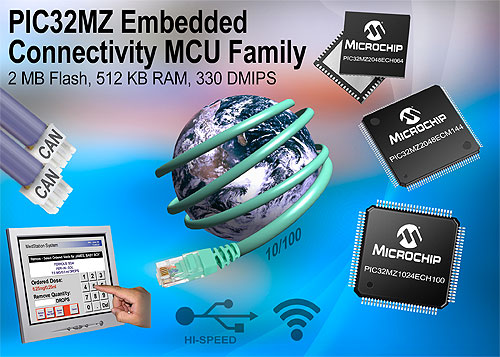Microchip Technology Inc., a provider of microcontroller, mixed-signal, analog and Flash-IP solutions, announced the new 24-member PIC32MZ Embedded Connectivity (EC) family of 32-bit MCUs. It provides class-leading performance of 330 DMIPS and 3.28 CoreMarks™/MHz, along with dual-panel, live-update Flash (up to 2 MB), large RAM (512 KB) and the connectivity peripherals—including a 10/100 Ethernet MAC, Hi-Speed USB MAC/PHY (a first for PIC® MCUs) and dual CAN ports—needed to support today’s demanding applications. The PIC32MZ also has class-leading code density that is 30% better than competitors, along with a 28 Msps ADC that offers one of the best throughput rates for 32-bit MCUs. Rounding out this family’s high level of integration is a full-featured hardware crypto engine with a random number generator for high-throughput data encryption/decryption and authentication (e.g., AES, 3DES, SHA, MD5 and HMAC), as well as the first SQI interface on a Microchip MCU and the PIC32’s highest number of serial channels.

Embedded designers are faced with ever-increasing demands for additional features that require more MCU performance and memory. At the same time, they are looking to lower cost and complexity by utilizing fewer MCUs. The PIC32MZ family provides 3x the performance and 4x the memory over the previous-generation PIC32MX families, along with a high level of advanced peripheral integration. For applications requiring embedded connectivity, the family includes Hi-Speed USB, Ethernet and CAN, along with a broad set of wired and wireless protocol stacks. Many embedded applications are adding better graphics displays, and the PIC32MZ can support up to a WQVGA display without any external graphics chips. Streaming/digital audio applications can take advantage of this family’s 159 DSP instructions, large memory, peripherals such as I2S, and available software.
Field updates are another growing challenge for design engineers and managers. The PIC32MZ’s 2 MB of internal Flash enables live updates via dual independent panels that provide a fail-safe way to conduct field updates while operating at full speed.
“Our new PIC32MZ family was designed for high-end and next-generation embedded applications that require high levels of performance, memory and advanced-peripheral integration,” said Rod Drake, director of Microchip’s MCU32 Division. “The PIC32MZ enables designers to add features such as improved graphics displays, faster real-time performance and increased security with a single MCU, lowering both cost and complexity.”
The PIC32MZ is Microchip’s first MCU to employ Imagination’s MIPS microAptiv™ core, which adds 159 new DSP instructions that enable the execution of DSP algorithms at up to 75% fewer cycles than the PIC32MX families. This core also provides the microMIPS® instruction-set architecture, which improves code density while operating at near full rate, instruction and data cache, and its 200 MHz/330 DMIPS offers 3x the performance of the PIC32MX.
“Microchip is a flag-bearer for the MIPS architecture in microcontrollers, having created its performance-leading PIC32 line around MIPS. Additionally, Microchip was a valued partner in defining the feature set for the new MIPS microAptiv CPU, which is designed to fulfill next-generation application demands for increased performance and functionality,” said Tony King-Smith, EVP Marketing, Imagination Technologies. “With its new microAptiv-based PIC32MZ family, Microchip is again taking MCU performance and feature innovation to new levels. Imagination is delighted with this latest achievement of our strategic relationship with Microchip to address ever-evolving market needs.”
Development Support
Microchip is making four new PIC32MZ development tools available today. The complete, turn-key PIC32MZ EC Starter Kit costs $119, and comes in two flavors to support family members with the integrated crypto engine (Part # DM320006-C) and those without (Part # DM320006). The Multimedia Expansion Board II (Part # DM320005-2), which is available at the introductory rate of $299 for the first six months and can be used with either Starter Kit to develop graphics HMI, connectivity and audio applications. The 168-pin to132-pin Starter Kit Adapter (Part # AC320006, $59) enables development with Microchip’s extensive portfolio of application-specific daughter boards. The PIC32MZ2048EC Plug-in Module (Part # MA320012, $25) is available for existing users of the Explorer 16 Modular Development Board. For more information and to purchase these tools, visit http://www.microchip.com/get/JDVB.
Pricing and Availability
The first 12 members of the PIC32MZ family are expected starting in December for sampling and volume production, while the remaining 12, along with additional package options, are expected to become available at various dates through May 2014. The crypto engine is integrated into eight of the PIC32MZ MCUs, and there is an even split of 12 MCUs with 1 MB of Flash and 12 MCUs with 2 MB of Flash. Pricing starts at $6.68 each in 10,000-unit quantities. The superset family members and their package options are the 64-pin QFN (9×9 mm) and TQFP (9×9 mm) for the PIC32MZ2048ECH064; 100-pin TQFP (12×12 and 14×14 mm) for the PIC32MZ2048ECH100; 124-pin VTLA (9×9 mm) for the PIC32MZ2048ECH124; and 144-pin TQFP (16×16 mm) and LQFP (20×20 mm) for the PIC32MZ2048ECH144. The superset versions with an integrated crypto engine are the PIC32MZ2048ECM064, PIC32MZ2048ECM100, PIC32MZ2048ECM124 and PIC32MZ2048ECM144.
Microchip
www.microchip.com

Leave a Reply